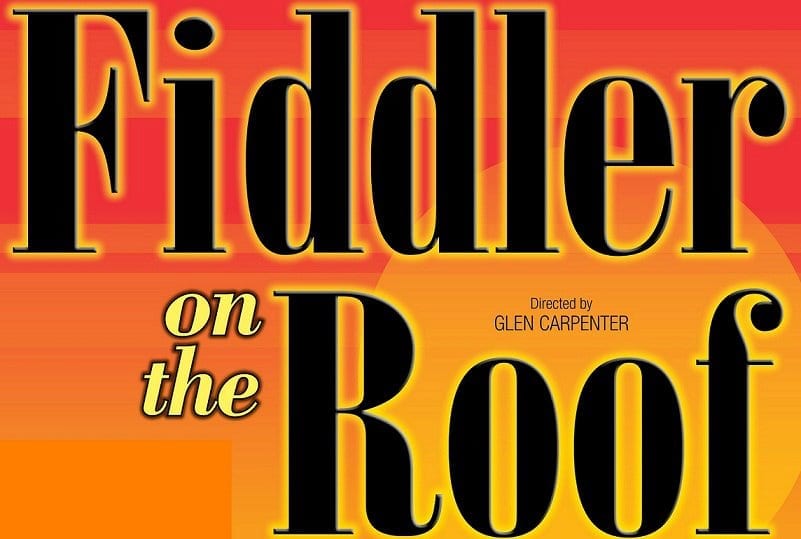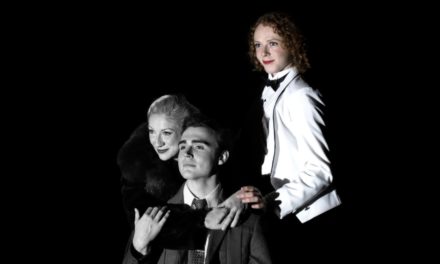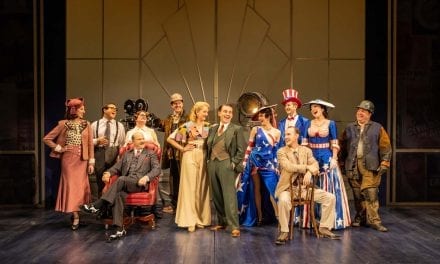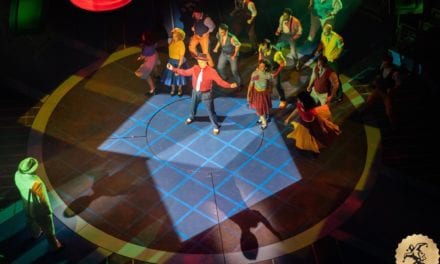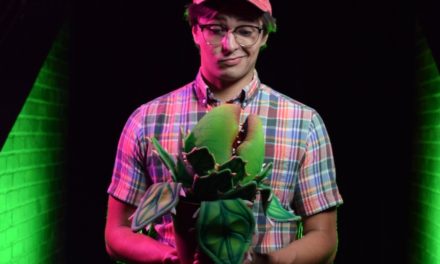STANSBURY PARK — According to the program note of director Glen Carpenter, Fiddler on the Roof is “ranked as one of this state’s most requested shows [in] every community theatre, in any town in Utah.” A musical about the power of traditions in keeping one’s faith, the show itself has become a Utah tradition. The story follows Tevye (Shawn Maxfield) as he raises his five daughters in the small Russian village, Anatevka. Against a backdrop of Russian and Jewish tension, Tevye must decide how far he can bend as his three oldest daughters choose, in varying degrees, to defy the longstanding traditions of the village and the faith.

Show closes August 13, 2012.
The Benson Gristmill Performing Arts Foundation did well in selecting Fiddler on the Roof for its summer production. Incorporating the setting of the historical buildings at the grist mill, the stage included an existing log home, a raised platform stage, and the ground level of the outdoor field area. The audience sat in a small section of bleachers and rows of folding chairs set on the same level as the main stage area. Watching Golde (Amy Bodily) and the rest of the family enter and exit from the Forsmyth Pioneer Cabin, built in 1872, reinforced the production’s 1905 time period.
However, because of the main level seating, I was generally only able to see the actors from the shoulders up. This facility did not do Becca Hall’s choreography justice. Hall’s choreography delivered all the traditional movements but took the storytelling to a whole new level. My favorite moments in dance (that I could see) were “Matchmaker” and “Miracle of Miracles,” which both used dynamic movement which also supported the story. I was impressed by the ability of the cast to carry out Hall’s ambitious movement without letting it negatively affect their vocal consistency, especially in the case of Motel (Tyler Egan) who sang almost effortlessly while carrying out the athletic moves. The post-wedding dance in which Perchik (Abram Beazer) and Hodel (Kacy Carr) encourage the village to take up dancing was as polished as it was energetic, and I enjoyed watching the dancers perform on a variety of levels.
Compared with such skilled dancing, I was a bit disappointed in the bottle dance. It was clear that the bottles were attached to the hats, and several performers spent the majority of the dance trying to re-position their bottle. The additional movement was distracting. I would have preferred to see the traditional approach wherein a dancer who loses his bottle removes himself from the “game.” Additionally, the “Chavaleh” dance, while beautiful, did not seem to fit in with the story line. Five dancers of approximately the same age performed a polished routine on the raised platform, but it was unclear which, if any, represented Chava (Sammie Grimes) until she ultimately was left as the only one on the stage.

Shawn Maxfield as Tevye. Photo by Maegan Burr.
I was consistently impressed by the quality of sound, taking into account the challenges of an outdoor theater and the high levels of wind during the performance. Carpenter made a wise decision in casting a very large ensemble, and the ensemble worked hard to project the sound above the wind and occasional traffic noise. The sound board operator (Katie Ditty) did an excellent job of blending the amplified sound of the lead actors into the natural sound of the ensemble, and the microphones performed surprisingly well in the wind. On rare occasions, such as during the more drunken moments of “To Life,” the exuberance of the actors overloaded the microphones, but in general, the sound was clear and well-balanced.
The lead actors in this cast each exhibited specific strengths. Egan had an excellent voice and portrayed a quirky Motel that I couldn’t help but root for. Yente (Elayne Pearson) was consistently amusing, delivering her many humorous lines with skilled comedic timing. Tzeitel (Kate Corbett) had many good moments, but my favorite was her impression of Yente in “Matchmaker.” I enjoyed Bryan Ditty’s hearty chortle in his portrayal of Lazar Wolf. Scott Carr (playing Fyedka) impressed me first with his soaring high notes during “To Life” and then was the most dynamic of the Russian dancers throughout the remainder of the song. And Kacy Carr’s facial expressions added depth and dimension to her portrayal of Hodel.
In the same way that Tevye is able to look at the “other hand” of any situation, there are many good ways to play the part of Tevye. In this case, Maxfield excelled most in Tevye’s humorous aspects. His physical humor in “If I Were a Rich Man” and in response to Golde’s badgering made this Tevye a particularly endearing character. Although his dialogue in “Tradition” seemed occasionally rushed by the use of a prerecorded accompaniment track, and there were a few rough rhythmic patches in “Tevye’s Dream,” Maxfield showed exceptional musicality in “If I Were a Rich Man” and delivered consistent and poignant melodies in “Sabbath Prayer,” “Sunrise, Sunset,” and “Chavaleh.” Despite his many great moments throughout the show, his character was most impressive in response to Chava’s marriage. In his voice I heard a wide array of emotions, through sorrow, shame, love, anger, and regret.
Costumes and makeup designed by Carpenter and Jorden Cammack definitely added to the magic in “Tevye’s Dream.” In particular, Grandma Tzeitel (Leslie Taylor) and Fruma Sarah (Pamela Giles) were spectacularly outfitted and played up their roles to the furthest extent possible. At other moments, however, I was distracted by inconsistent costuming including a bottle dancer who appeared to be wearing blue jeans during the wedding sequence. While the majority of the props, designed by Diana Troop and Thiel Peck, seemed appropriate, the use of mops during “Matchmaker” felt out of place.
Although there are many expected and anticipated moments in Fiddler on the Roof, Carpenter built on the traditional moments to add new life to a well-worn show. One of my favorite moments of the show was when, instead of having the villagers leave Anatevka during the song, Carpenter staged Tevye and Golde in a position to stand silently watching the trail of neighbors as they collected their belongings and exited the city. As the last of the villagers passed, Tevye motioned for The Fiddler (Madison Libby) to retire, and the lights went down on the show. This non-traditional approach added an emotional finale I just wasn’t expecting and provided a quiet moment to reflect on the show’s themes.
If you live on the west end of the Salt Lake Valley, the drive to the Benson Grist Mill in Stansbury Park feels shorter than expected, and this production of Fiddler on the Roof is well worth the drive. Be prepared for a late night, as the show doesn’t start until 8:30 PM. I’ll admit to being quite tired by the 11:20 PM finish, but I could see the wisdom in the late start as the lighting effects added to the emotion of the show. If you come out to the production, you may want to bring a bit of extra cash. There are food vendors on site, and the barbeque smelled particularly delicious. I also enjoyed visiting the country store during intermission and could have done some early Christmas shopping if I’d been better prepared. If you’re not able to make it to this production, put the Benson Gristmill Performing Arts Foundation on your radar; I imagine the quality of this production is part of their tradition.

